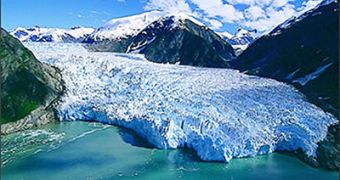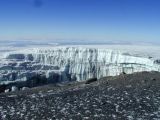In small amounts ice is a solid, brittle, crystalline material. But in ticker layers, of 60-100 m (200-330 ft), the part situated underneath behaves like a plastic material, engaged in a slow flow, so that the whole ice mass spreads over an extended area or displace on slopes. That's why a glacier behaves like a slow flowing ice river.
Glaciers form in the high peak of the mountains, in the debris-filled valleys. The snowfall from the previous winters that resists to the melting or evaporation (ablation), called firn, becomes compact in several years, turning into a viscous mass like an ice river. By the melting and re-freezing of the upper layer, the snow is turned into granulated ice, the first being the small horizontal ice formations, called ice lenses, which harden under the pressure of the upper layers, and is turned into crystalline dense compact ice.
When the ice layers get so thick that the bottom layers turn plastic, the slow downward flow of the ice accumulated in the high mountains is triggered by gravitation, the glacier being active now.
Very few glaciers reach the sea. This occurs mainly in the Arctic (Svalbard, Greenland, the Canadian Arctic Archipelago) and Antarctica. Very few Alaskan glaciers reach the gulfs, fjords or shores.
Glaciers generated on the high mountains are usually narrow and long, as they occupy pre-existent valleys. While moving towards lower altitudes, where temperatures are higher, the glaciers experience ablation and the ice is lost.
The origin valley of a glacier is named glacial cirque (accumulation zone). The firn territory is smooth, presenting a concave profile in transversal section. At the moment of complete filling of the cirque with ice, the extra ice leaves the region through the so-called glacial sill. The flowing speed increases in this sector, where deep crevasses appear, forming a glacial fall. In the lower part of the valley, in the ablation zone, the ice losses mass through melting and evaporation. The rapidly melting uncovers elder ice layers from below, with many rugosities and deep crevasses.
With its advance, the glacier grinds through rubbing the ground, engaging in its movement all that it meets: debris, rocks, sand, soil, and other materials named moraines. On the front of the glacier, the moraine materials are piled. The moraine mass transported by one glacier can add to that of another it meets in its way. In the terminal part of the glacier, the accumulated moraines can stop the advance of the glacier, anchoring it. This causes another phenomenon: the melting and cracking of the ice. Most glaciers look, in their terminal part, like a mosaic of cracks.
Molten water pours from hidden channels and tunnels. In its lower part, the glacier has a convex transversal profile, its central part being higher than its sides.
A land glacier is in a dynamic balance, in which the intensity of the accumulation in the cirque is equaled by the ablation in its lower part. Even if it flows, a balanced glacier maintains its length and transversal section. Sometimes, two glaciers originating in two different circuses can unite. This can cause a balance compensating the losses through ablation.
If the glacier reaches the sea, due to the waves and the advancing back mass of ice, cracks occur and the ice masses can break off, forming floating icebergs.
Types of glaciers
11 % of the land surface is covered by ice (23 million square km): 14.1 million form the ice pack and sheet in Antarctica, 21,000 square km in mountain glaciers in southern temperate zone, 100 square kilometers in tropical mountain glaciers, 100,111 square km in mountain glaciers in northern temperate zone and 2.2 million square km in the Arctic (1.65 in Greenland alone, the rest in the Canadian Arctic archipelago and other Arctic archipelagos: Novaia Zemlea 22,600 square km, Svalbard 30,800 square km, Severnaia Zemlea 15,600 square km).
97 % of the current ice surface and 99.75 % of its volume are located in Antarctica and Greenland. (90 % in Antarctica, with 29.46 million cubic km of ice: this is 66 % of the fresh water amount on Earth!). 7 million square km of the ocean are covered by ice in winter. 75 % of the world's fresh water reserves are located in ice; the total ice melting would raise the sea levels by 60 m (200 ft). During the Ice Age, they covered 38 % of the land surface and, in North America reached the latitude of 40? N, and the Alps were covered by a single huge ice cap, whose relict glaciers can still be seen.
In some cases, the mountain glaciers can have the aspect of small ice sheets, being called plateau glaciers, like in Pamir Mountains, New Zealand Mountains, or Swiss Alps.
Valley glaciers are found in very steep slopes. They can be of the Alpine flowing type, with an accumulation zone of firn. The Himalayan type glaciers are larger than those from the Alps and branched, like Fedcenko Glacier (Pamir, Tajikistan) which is 71 km (45mi) long and with a surface of 907 square km, or Inylchek from Tian Shan Mountains, which is 60 km (47 mi) long, with a surface of 255 square km.
A Kilimanjaro type is the one found in the craters of the volcanic cones, presenting radial languages. The Scandinavian is represented by ice mattresses on higher plateaus that slowly flow to the bottom of the fjords.
Losing the glaciers
Sometimes, mountain glaciers can experience sudden episodes when they go downwards up to 60 m (200 ft), wiping out everything in their way. Generally, the flow used to be very slow, from a few centimeters to a few meters daily. But earthquakes, deforestation, pollution and, especially, global warming, are now speeding up the alpine glaciers.
Glaciers are no more balanced: most of the current alpine glaciers will be lost in less than a half century. Some glaciers now surpass speeds of 65 m/day and, overall, the speed of the glaciers has doubled since 1989. In tropical areas they retreat with 30 % each century, in temperate areas with 1-15 %. At the beginning of the XX century, there were 239 glaciers in the Italian Alps, and in 1950 there were just 163! In Greenland, the retreat is of 3-6 % and in Antarctica 0.5-3 %.
Average glacial shrinkage increased from 30 cm (1 ft) per year, between 1980 and 1999, to 0.5 m of 'water equivalent' in 2005 and 1.4 m (4.6 ft) of 'water equivalent' in 2006. The heaviest losses were experienced by glaciers in the European Alps and Pyrenees mountain ranges. The record annual loss in the period 1980-1999 (0.7 m or 2.3 ft in 1998) was overrun in 2003, 2004 and 2006. The total loss in ice thickness, since 1980, could be more than 11.5 m (38 ft).
The most intense ice loss is occurring in glaciers from Austria, Norway, Sweden, Italy, Spain and Switzerland. The Norwegian Breidalblikkbrea glacier lost almost 3.1 m (10.3 ft) in one episode representing one of the most spectacular ice losses.
These numbers would mean that the Alps' glaciers would disappear in 300 years and those in Greenland in about 1,600 years. Recent measurements revealed instead that, at the current melting rate, this could occur in fact in less than 100 years.
Even tropical glaciers are fast receding, from Andes to Africa. African Ruwenzori Mountains have lost 50% of their ice crown in the last 50 years. The Ruwenzori glaciers fluctuated from an area of 1,600 acres (650 ha) in 1906 to 870 acres (352 ha) in 1955 to just 366 acres (148 ha) in 2008 and they could be gone in 30 years. Other African mountain glaciers will be gone within 25 to 50 years. Kilimanjaro is the highest African mountain (5890 m or 19,630 ft) and Mount Kenya is the second highest mountain in Africa (5199 m or 17,330 ft). Kilimanjaro has already lost 82 % of its ice cover in 80 years. Mount Kenya has lost 92 % of its ice cap in the last century.

 14 DAY TRIAL //
14 DAY TRIAL // 
